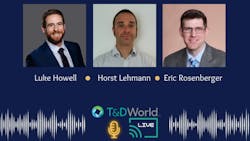T&D World Live Podcast: Dynamic Line Ratings: PPL’s Blueprint for a Smarter Grid
In this episode of the T&D World Podcast, we speak with Horst Lehmann and Eric Rosenberger of PPL Electric Utilities, and Luke Howell of Ampacimon, about the implementation and benefits of Dynamic Line Ratings (DLR) in electric utilities. The conversation explores how DLR technology uses real-time environmental data — such as wind, temperature, and solar radiation — to more accurately determine the capacity of transmission lines, allowing utilities to increase system efficiency, reduce congestion, and defer costly infrastructure upgrades.
Listen Now
PPL Electric became the first U.S. utility to operationalize DLR in real-time. Lehmann and Rosenberger explain how the company used DLR to resolve transmission congestion without pursuing multimillion-dollar reconductoring projects. Instead, they leveraged DLR to optimize energy dispatch through better collaboration with PJM, their regional transmission organization. While sensor installation was relatively straightforward, the more complex work involved integrating DLR data into their Energy Management System (EMS), ensuring the reliability of that data, and managing secure end-to-end communication across the system.
The team emphasizes that integration challenges — especially around cybersecurity — must be carefully addressed. Because DLR directly influences power flow in real time, the system had to meet NERC CIP standards from the outset. PPL chose an on-premise deployment to maintain control over their infrastructure and ensure compliance. From Ampacimon’s perspective, adapting to the cybersecurity requirements of different utilities and regions is essential to the successful rollout of DLR.
Operational risk management is another key theme. Since DLR systems rely on sensor and server performance, PPL created fallback processes to automatically degrade ratings when data is lost. If the entire DLR system were to fail, PPL would revert to ambient-adjusted ratings to maintain safety and reliability. So far, DLR has been implemented on a select number of lines, but the discussion makes clear that scaling up would require careful planning around redundancy.
The episode also explores how PPL determined which lines to prioritize for DLR installation. They began by running simulations using wind data and congestion models, and ultimately saw even greater performance in real-time use than in the initial modeling. These insights not only validated the technology but also led to the cancellation of a major planned upgrade. The speakers stress that DLR is not appropriate for every line — it’s most effective in areas with congestion, high wind generation, or significant load growth, such as from data centers.
Beyond DLR, the guests discuss other grid-enhancing technologies like static VAR compensators, synchronous condensers, and battery storage. These tools each address specific challenges as utilities work to support growing demand and increased renewable energy penetration. While no single solution can solve all problems, technologies like DLR can play a major role in cost-effectively strengthening the grid.
PPL’s deployment of DLR has already drawn interest from other utilities, and the team is openly sharing lessons learned to help others follow a similar path. The episode concludes with a preview of their upcoming session at T&D World Live in Phoenix, where they’ll present more details about their DLR integration, system architecture, cybersecurity planning, and operational outcomes. For utilities considering a move beyond pilot projects, this episode offers both inspiration and practical advice.
To listen and subscribe go to https://tanddworld.podbean.com/
About the Author
Christina Marsh
Senior Editor
Christina Marsh is senior editor of T&D World at Endeavor Business Media (EBM), responsible for managing, editing, and contributing to the print issue production in addition to e-newsletters and digital content including podcasts. Previously, Christina was editor of Airport Business at EBM where she was responsible for contributing editorial support for the magazine, writing and compiling e-newsletters as well as contributing to digital content including producing video and podcasts. Before working with EBM, Christina was a multimedia journalist and podcast producer at The Experimental Aircraft Association (EAA). She graduated with a B.S. in journalism from the University of Wisconsin Oshkosh.

